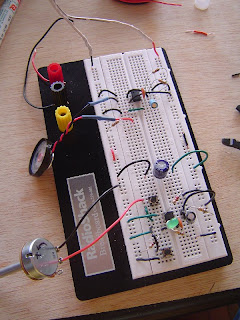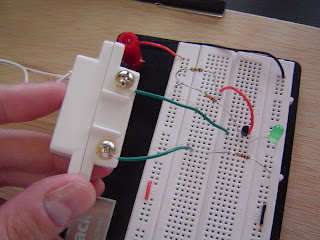
I gathered the Chapter 4 components and tools from a variety of sources.
Below, I've included description, part #, price, and where purchased.
Looking online, I paid way more than I should have for the various chips, but I was able to obtain them locally and visually inspect them. I also got a 20 minute education in other chips, so I figure the extra I spent was worth the extra information... future chip purchases, however, will likely come from Mouser.com where I think I see the best prices... please feel free to chime in about what you've found in terms of prices.

Components
ACK Supply for all chips below:
555 Timer chips x10, CA555E RCA, $0.80 each
$1.59 each for
CD74HC00E RCA
CD74HC02E RCA
CD74HX04E RCA
CD74HC08E RCA
CD74HC32E RCA
CD74HX86E RCA
CD4026BE RCA, $2.59 each
7492, $2.05 each
7406, $1.67 each
74LS27, $1.59 each
-----
Radio Shack Online items below
Item: 2761995
Description: 8-Pin Retention Contact
Quantity: 5 @ $.48
Item: 2761999
Description: 14-Pin Retention Contact
Quantity: 5 @ $.99
Item: 2761998
Description: 16-Pin Retention Contact
Quantity: 5 @ $.99
-----
AllElectronics.com items below
12-key numeric keypad - KP-12 (12 BUTTON KEYPAD - (KP-12)) $4.95
-----
Mouser.com components below
638-HLMPK150 Red LED, 660nm, $0.18 each
604-BC56-11EWA,HI EFF RED DIFFUSED numeric display, $2.73 each
Latching Relay 769-DS2E-SL2-DC5V 2A 5VDC DPDT, $4.86 each
10K Trimmer 652-3266Z-1-103LF 1/4" 10Kohms 10% $2.94 each
Voltage Regulator 512-LM7805CT 1A Pos Vol Reg , $0.37 each
Tactile Switches (already purchased for earlier chapter)
-----
Radio Shack Store components below
100K Potentiometer, 271-092 $2.99 each
10K Potentiometer, 271-1715 $2.99 each
5K Potentiometer (already purchased for earlier chapter)

 On another note -sorry for the delay in posts. We've had a death in the family and I'll resume posting on Tuesday when I get back in town.
On another note -sorry for the delay in posts. We've had a death in the family and I'll resume posting on Tuesday when I get back in town.


















































